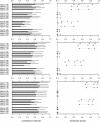A Bayesian hierarchical model for detecting haplotype-haplotype and haplotype-environment interactions in genetic association studies
- PMID: 21778734
- PMCID: PMC3153342
- DOI: 10.1159/000324841
A Bayesian hierarchical model for detecting haplotype-haplotype and haplotype-environment interactions in genetic association studies
Abstract
Objective: Genetic association studies based on haplotypes are powerful in the discovery and characterization of the genetic basis of complex human diseases. However, statistical methods for detecting haplotype-haplotype and haplotype-environment interactions have not yet been fully developed owing to the difficulties encountered: large numbers of potential haplotypes and unknown haplotype pairs. Furthermore, methods for detecting the association between rare haplotypes and disease have not kept pace with their counterpart of common haplotypes.
Methods/results: We herein propose an efficient and robust method to tackle these problems based on a Bayesian hierarchical generalized linear model. Our model simultaneously fits environmental effects, main effects of numerous common and rare haplotypes, and haplotype-haplotype and haplotype-environment interactions. The key to the approach is the use of a continuous prior distribution on coefficients that favors sparseness in the fitted model and facilitates computation. We develop a fast expectation-maximization algorithm to fit models by estimating posterior modes of coefficients. We incorporate our algorithm into the iteratively weighted least squares for classical generalized linear models as implemented in the R package glm. We evaluate the proposed method and compare its performance to existing methods on extensive simulated data.
Conclusion: The results show that the proposed method performs well under all situations and is more powerful than existing approaches.
Copyright © 2011 S. Karger AG, Basel.
Figures



References
-
- Botstein D, Risch N. Discovering genotypes underlying human phenotypes: past successes for mendelian disease, future approaches for complex disease. Nat Genet. 2003;33(suppl):228–237. - PubMed
-
- Risch N, Merikangas K. The future of genetic studies of complex human diseases. Science. 1996;273:1616–1617. - PubMed
-
- Clark AG. The role of haplotypes in candidate gene studies. Genet Epidemiol. 2004;27:321–333. - PubMed
-
- Davidson S. Research suggests importance of haplotypes over SNPs. Nat Biotechnol. 2000;18:1134–1135. - PubMed
Publication types
MeSH terms
Grants and funding
LinkOut - more resources
Full Text Sources

